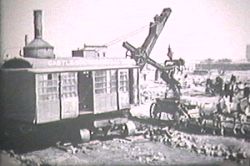 | |||||||
| Home | Email Us | Find It | What's New | Back | Next | ||
| PICTURE ALBUMS |
|
In the Beginning The Long Island Rail Road Station Maple Grove Cemetery and Vicinity Kew Cards Homes of Kew Lefferts Boulevard and Vicinity Queens Boulevard and Vicinity Metropolitan Avenue and Vicinity Kew Garden Apartments Kew Gardens in the News PS99 Photographs and More |
| VIEWER MESSAGES | ||
|
| MISCELLANEOUS | ||||
|
||||
 Click image to enlarge
A steamshovel at work on construction of the Long Island Railroad electrified tracks, location unknown.
|
The Maple Grove Realignment
[The following is an excerpt from Vol. 7, Vincent F. Seyfried, The Long Island Rail Road - A Comprehensive History, pp. 150 - 52 (1984)]
The Maple Grove relocation was a project to reduce the curvature of the Main Line track at the present Kew Gardens. Fortunately for the railroad, the whole area in the neighborhood of Union Turnpike was in 1908 still open country with a very few farmhouses and no street pattern. The Long Island Rail Road, on the eve of the opening of the Penn Tunnels, wanted a straight, low grade, four-track high speed road between New York and Jamaica, and a realignment of the roadbed at Maple Grove would both straighten the road and reduce the distance by not quite a half mile. The new cut-off began at the present 84th Drive on the east and continued to about the present Ascan Avenue in Forest Hills. The old line ran straight from Winfield [Ed. - today's Elmhurst] to within a few feet of Queens Boulevard at Lefferts Avenue [Ed. - today's 82nd Avenue] and then curved sharply southeast and around the southern edge of Maple Grove Cemetery, producing a sharp and undesirable radius of curvature. East of Lefferts Avnue, the new cut-off passed through the high ground of the A. P. Man estate, the Richmond Hill Golf Club, and on the west side of the turnpike, through farms recently acquired by the Cord Meyer Development Company. The railroad, after consultation, careful study and negotiations between the engineers of the railroad and the city, established a grade line for the railroad that significantly reduced the old gradient and so made it possible to achieve a higher rate of speed. Maple Grove Station, at that time only 500 feet south of Kew Gardens Road (old Newtown Avenue), was now about to be moved about 600 feet south farther down Lefferts Avenue to a new site north of the tracks and on the west side of Lefferts Avenue.
Much of the success of the Maple Grove cut-off was due to the good will of Alrick H. Man, the founder of Richmond Hill. The railroad bought out his estate of 25 acres on the west side of the turnpike and also the property of the Richmond Hill Golf Club also owned by Man, which organization was now forced out of existence since the new cut-off cut the grounds in two. Alrick Man, who in 1908 still owned a large part of Richmond Hill and many of its fine houses, gained materially by the railroad move since the railroad station would not be far closer to the built-up section of Richmond Hill. He also lost no time in cutting streets through the golf club property nearest the new "Kew" station and building handsome high quality houses in what was already an exclusive, expensive section.
Although this mile and a half of relocation was a costly one - roughly $500,000 - the railroad felt the heavy expense was justified on the ground that the improvement was a permanent one and that it affected the main line of the road, so that all Long Island would be benefitted by shorter running time.
During September 1908 preliminary work began on the Maple Grove cut-off before the Glendale cut-off could be finished. The four-tracking of the main line was planned at the same time and all the massive new bridges were designed for four tracks east of the Glendale cut-off and six tracks to the west. ... .
In November 1908 a number of substantial wooden barracks were erected on the railroad's property by the contractor in Forest Hills, the heavy machinery was rapidly being assembled and steam shovels were soon to begin work at Kew Gardens and near Forest Hills. Winter slowed down progress but work began in earnest in March 1909. . . . So rapidly did the work go all during the summer of 1909 that by September both grading and track laying had been completed. On September 4th Main Line service opened over the Maple Grove cut-off and through Forest Hills.